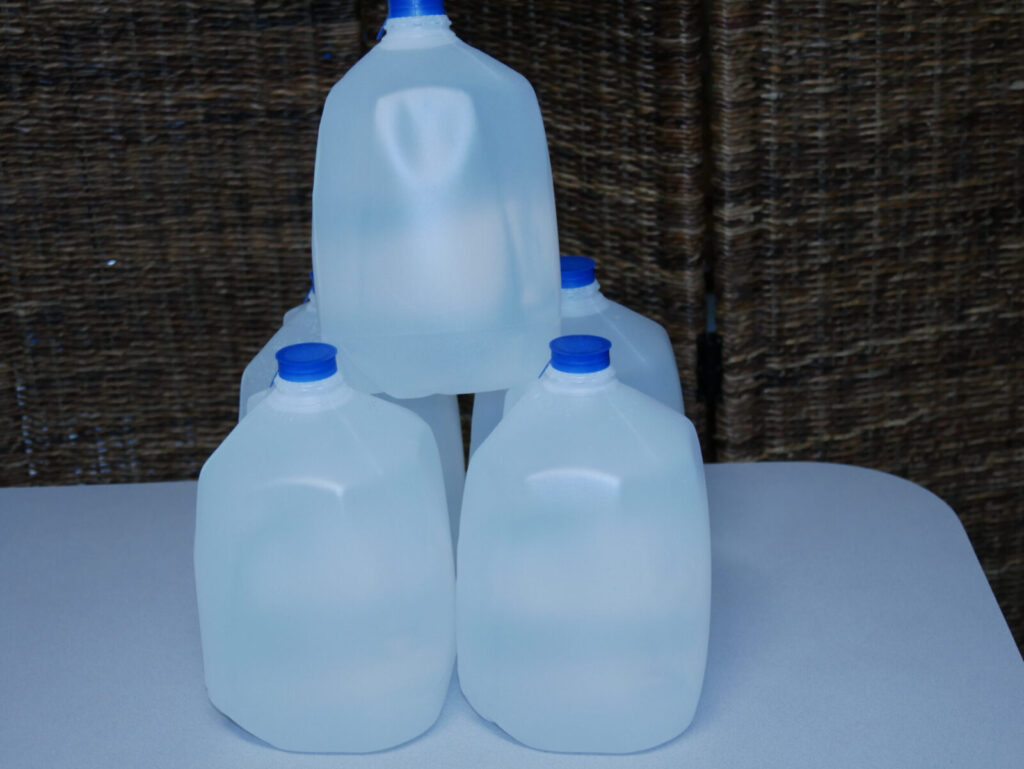You may have heard of the water quality issues that have plagued Flint, Michigan, for years. Discolored, off-tasting, and foul-smelling water signaled a public health crisis due to lead contamination.
Many homeowners drink, bathe, and cook with the water that comes straight from the tap, but is it safe?
We reached out to Eric Yeggy, Technical Affairs Director for the Water Quality Association. Eric has a degree in chemistry from the University of Northern Iowa and spent more than 20 years in the environmental testing industry studying the analytical chemistry of drinking water, ground water, and soil. Read below to learn tips from the WQA on how to check if your house water is clean and safe!
Is it safe to drink tap water in the U.S.?

“Generally speaking, I would say we have some of the safest water in the world in the United States, but it’s not always harmless as we have seen in many cases,” says Eric.
As mentioned earlier, lead polluted the water in Flint, and though lead is dangerous and deadly, especially to children who are more susceptible, there are other contaminants that can make their way into a home’s drinking water, too.
The most common contaminants of private wells include arsenic, radiological contaminants, bacteria, and nitrate, but lead, copper, and disinfection byproducts are very common contaminants in municipal water. This list doesn’t include emerging contaminants such as polyfluoroalkyl substances (PFAS).

“That’s the non-stick coating stuff and is used in firefighting foam,” says Eric. “PFAS is a class of chemicals that’s very dangerous and has made its way into our water supplies and our groundwater.”
These substances are nicknamed “forever chemicals” because they are not destroyed by any processes in nature.
“These [chemicals] are all unregulated,” says Eric, “so they’re not necessarily things that even your city would be testing for if you’re getting municipal water.”
Water contaminants can create a wide range of acute and chronic health issues. “Acute” issues include immediate reactions, such as bacteria that can make a person sick overnight or even nitrate that can cause baby blue syndrome and lead to death. “Chronic” health effects come from substances such as arsenic, which can cause cancer over a prolonged period of time.
There are also aesthetic water quality issues that homeowners may want to test for, such as hardness, iron, and manganese, which can damage appliances and plumbing.
“It’s very complex in terms of what is the most dangerous or what people should be concerned about,” says Eric.
How can you check your drinking water’s quality?

The WQA provides a list of water treatment professionals on their website who, as WQA members, have agreed to abide by a strict code of ethical business conduct. These professionals can guide you on the contaminants for which you should test. The search tool also indicates whether the companies have certified professionals on staff, which is above and beyond what the ethical code requires.
“These professionals have pursued technical training, taken and passed a test, and are doing ongoing continuing education to maintain that certification,” says Eric.
Many water treatment professionals will also do the testing for you, but for health-related contaminants you should confirm that they are using a certified drinking water laboratory. Some aesthetic contaminants such as hardness and pH can be accurately tested in the home.
Private well owners also should contact their county health department.
“The county health department probably may have a list of all the contaminants that have been found in the aquifers in your area, so they can help you decide what you need to test for.”
Eric Yeggy, Technical Affairs Director for the Water Quality Association
They may also be able to do testing for free or give you testing at a discounted rate.
You can also reach out to the EPA Drinking Water Hotline or conduct a state search online. Many states publish reports about the contaminants they’ve found in the aquifers and drinking water supplies as well as the water quality standards for drinking water.
Certified drinking water laboratories in your area may also have developed test packages based on common drinking water contaminants and can be a great resource to consult with when you are deciding what to test.
Homeowners can also contact WQA or consult free resources offered through the WQA website.
Before you hire a water professional

If your professional is completing a precipitation test to show the hardness of the water, the test uses chemistry and electricity to cause the minerals in your water to turn color, generally a very dark brown or blackish color. This test can be done in an ethical way and an unethical way.
“If the water treatment professional tries to convince you that [the dark color of the water] is a sign of pollution or dangerous chemicals in your water, then you’re dealing with someone who’s either unethical or does not know what they’re talking about.”
A professional saying the test shows “all the pollution you’ve been drinking” is a clear red flag. A precipitation test does not show pollution.
This test is a very simple and reliable way to determine the level of hardness of your water.
Are home water quality test kits accurate?

If you’re testing hardness in water, a water quality test from a big box store can be a viable option. When testing for health-related contaminants in water samples, contact a certified drinking water laboratory.
Explains Eric, “There’s some home test kit for lead, but they only capture dissolved lead. If you were following any of the stories like Flint, Michigan, more than 90% of the lead that was impacting people was particulate lead, meaning it was in a solid form that won’t be picked up by that type of test. Testing for particulate lead requires a heated-acid digestion, and that’s why you have to send it to a laboratory.”
Your drinking water isn’t as clean as you thought. Now what?
“The laboratory that did the testing should be able to tell you what the results mean,” says Eric.
The laboratory can advise if you’ll need to investigate further or stop drinking your tap water immediately. Some issues can easily be resolved, while some may require more drastic measures.
“If bacteria is the only issue, boiling the water can make it safe to drink and provide you with the short-term solution,” explains Eric. “If it’s chemicals, they can’t be removed by boiling.”
Using bottled water can also protect the health of your family until you have a more permanent solution in place.

For long-term solutions, you can install an in-home treatment system which has been tested and certified by independent third-party agencies to remove common chemical contaminants. The WQA’s website lists products that are certified to remove a specific list of contaminants, and the certification includes more than just performance.
Explains Eric, “It also looks at safety and structural integrity, which by safety, we mean, ‘What are the materials that are used to construct that product?’ Those materials are going to be in contact with your drinking water. We test them to make sure that they’re not going to be leaking any harmful chemicals into your drinking water.”
The WQA also tests the structural integrity of these products to ensure they won’t leak or burst in your basement or under your sink, which can lead to expensive damage and other health concerns, such as mold.
Filter out the contaminants
There are many different types of treatment technologies that are available for in-home use. Some of the common ones are water filters, softeners, reverse osmosis, and UV. Each of these technologies has strengths and weaknesses and is specifically designed for maximum removal of a set of specific contaminants.
Treat at the tap

Lead is one of the most common contaminants, but it can be difficult to tell if it’s coming from the plumbing in the home or from the public water system. Even plastic pipes in a home might have brass and bronze fittings, which could contain lead.
“We always recommend treating for lead at the point of use, at the sinks where you’re going to be drawing water for drinking and cooking,” says Eric.
The one thing homeowners need to know about their home’s drinking water
“In the world of chemistry, we refer to water as a universal solvent,” says Eric. “That’s because it’s capable of dissolving more substances than any other liquid we know.”
This is why the WQA always recommends homeowners test their water in the home. Each home is unique, and even private wells that tap the same aquifer can have vastly different water quality levels.

“We saw this play out in Flint where you had some homes where they had definitely dangerous levels of lead, whereas other homes had lead that was literally hazardous waste levels,” says Eric.
Water can dissolve many substances and become contaminated, even if it was pristinely pure when it left the treatment plant. By the time it reaches your home, it can be vastly different and potentially dangerous.
Water you waiting for? Learn more!
The best thing you can do for your home is learn about water quality and how to mitigate any contaminants. The WQA offers a free download of Water Treatment for Dummies that provides an overview of the various treatment technologies, information on specific contaminants questions, and questions to ask a water treatment professional before signing a contract.
The Water Quality Research Foundation also publishes scientific research on energy savings for softening water and offers a contaminant occurrence map, which may help you decide what to test for in your water.
Private well owners should check out the Private Well Class, a free online resource center with webinars and training videos that teach you how to protect your well and what to do when your well needs attention. We also spoke with Eric regarding well water safety on the vipHome Podcast!
Homeowners can also consult the Water Quality Association’s website for help finding a local water treatment professional who can help you test and treat your water or for lists of certified water treatment products, among other free resources.
Keep your home safe and secure
Homeownership can be hard, but it doesn’t have to be. The vipHome.app can help. In less than four minutes, enjoy a new way to manage your home. Simply download the app, register your home, and enjoy a simplified homeownership experience. Download the app today!





